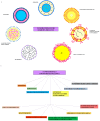Nanotechnology-Based Approaches for the Management of Diabetes Mellitus: An Innovative Solution to Long-Lasting Challenges in Antidiabetic Drug Delivery
- PMID: 39771551
- PMCID: PMC11678074
- DOI: 10.3390/pharmaceutics16121572
Nanotechnology-Based Approaches for the Management of Diabetes Mellitus: An Innovative Solution to Long-Lasting Challenges in Antidiabetic Drug Delivery
Abstract
Diabetes is a widespread metabolic illness. Mismanagement of diabetes can lead to severe complications that tremendously impact patients' quality of life. The assimilation of nanotechnology in diabetes care holds the potential to revolutionize treatment paradigms, improve patient outcomes, and reduce the economic burden associated with this pervasive disease. This manuscript explores the multifaceted utilization of nanomaterials in diabetes care, emphasizing the unique features of nano-based medication delivery methods and smart drug delivery mechanisms. Additionally, this paper talks about research on nanocarrier-integrated oral, transdermal, and inhalable insulin delivery; dendrimer- and nanocarrier-coupled antisense oligonucleotide-driven gene therapy; the implementation of gold nanoparticles and quantum dots for glucose surveillance; and nucleic acid therapies. There are certain restrictions when using medication delivery methods that are commonly available to handle diabetes. In order to increase efficacy and safety, the rapidly developing science of nanotechnology is also being explored and employed in medical biology. Nanomaterials like liposomes, dendrimers, niosomes, polymeric and metallic nanocarriers, and solid lipid nanoparticles are among the nanocarriers that have been developed for better delivery of various oral hypoglycemic agents in comparison to conventional therapies. These nanocarriers provide great control over elevated blood glucose levels, making them one of the most intriguing and promising technologies available today. Furthermore, adding additional ligands to nanocarriers allows for more focused distribution while protecting the encapsulated hypoglycemic drugs.
Keywords: blood glucose; diabetes mellitus; nanocarriers.
Conflict of interest statement
The authors declare no conflicts of interest.
Figures


Similar articles
-
Nanotechnology Advanced Strategies for the Management of Diabetes Mellitus.Curr Drug Targets. 2019;20(10):995-1007. doi: 10.2174/1389450120666190307101642. Curr Drug Targets. 2019. PMID: 30848199
-
Nanotechnology based approaches for anti-diabetic drugs delivery.Diabetes Res Clin Pract. 2018 Feb;136:52-77. doi: 10.1016/j.diabres.2017.11.018. Epub 2017 Nov 28. Diabetes Res Clin Pract. 2018. PMID: 29196152 Review.
-
Nanomaterial-Enhanced Microneedles: Emerging Therapies for Diabetes and Obesity.Pharmaceutics. 2024 Oct 21;16(10):1344. doi: 10.3390/pharmaceutics16101344. Pharmaceutics. 2024. PMID: 39458672 Free PMC article. Review.
-
A Review on the Delivery of Plant-Based Antidiabetic Agents Using Nanocarriers: Current Status and Their Role in Combatting Hyperglycaemia.Polymers (Basel). 2022 Jul 24;14(15):2991. doi: 10.3390/polym14152991. Polymers (Basel). 2022. PMID: 35893954 Free PMC article. Review.
-
Nanomaterials for diabetes: diagnosis, detection and delivery.Nanotechnology. 2024 Jul 11;35(39). doi: 10.1088/1361-6528/ad5db5. Nanotechnology. 2024. PMID: 38990067 Review.
Cited by
-
The Transformative Role of Nanotechnology in the Management of Diabetes Mellitus: Insights from Current Research.Biomolecules. 2025 May 1;15(5):653. doi: 10.3390/biom15050653. Biomolecules. 2025. PMID: 40427546 Free PMC article. Review.
-
Phospholipid-Drug Conjugates in Cancer Therapy: Emerging Paradigms and Future Directions.AAPS PharmSciTech. 2025 Jul 14;26(6):190. doi: 10.1208/s12249-025-03175-8. AAPS PharmSciTech. 2025. PMID: 40659903 Review.
-
Emerging Plant-Based Nanotechnological Advances and Molecular Insights for Type‑2 Diabetes, Diagnosis and Treatments-Recent Trends and Future Prospects.ACS Omega. 2025 Aug 4;10(32):35310-35326. doi: 10.1021/acsomega.5c01900. eCollection 2025 Aug 19. ACS Omega. 2025. PMID: 40852224 Free PMC article. Review.
-
Applications and prospects of biomaterials in diabetes management.Front Bioeng Biotechnol. 2025 Mar 7;13:1547343. doi: 10.3389/fbioe.2025.1547343. eCollection 2025. Front Bioeng Biotechnol. 2025. PMID: 40124248 Free PMC article. Review.
References
-
- World Health Organization Global Report on Diabetes. 2023. [(accessed on 24 June 2024)]. Available online: https://www.who.int/news-room/fact-sheets/detail/diabetes.
-
- International Diabetes Federation Diabetes Atlas. 2024. [(accessed on 25 June 2024)]. Available online: https://www.diabetesatlas.org.
Publication types
LinkOut - more resources
Full Text Sources

